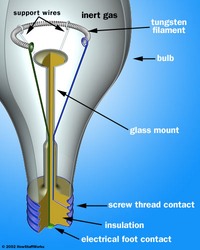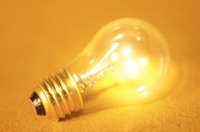The basics of an incandesecent light bulb:
The light bulb is a fairly simple structure with a few very important parts. If you look at the picture you will see two wires: a green one and a blue one. Both wires are connected to the base of the light bulb; the green wire is connected to the electrical foot contact while the blue wire is connected to the screw thread contact. The other ends of the two wires are attached to the filament, the filament is held up by a glass mount so that it is in the center of the glass bulb, which is going to be filled with a gas, like nitrogen and argon.
This is important because it makes a full closed circuit. Let me explain. The top line represents the green wire. Current, which consists of moving electrons will travel along the wire until it gets to the filament wire. The filament wire acts as a resistor (R) and uses the energy from the current and turns it into visible light. If current remains it travels down the blue wire and back out to the source of energy, for example in the picture below, it is a battery.

The Filament
As the electrons travel through the filament they heat up which makes the electrons move to a new energy level. As they cool off the electron jumps back down to its origonal position. As the electron is jumping back to its orginal position the energy lost is what produces lights. When the current passes through the filament it heats up the metal and as it heats up, depending on the metal, the filament can reach tempuratures as hot at 3000k or 5000°F thus making the metal glow white hot. The hotter the metal gets the whiter the glow will be this is why modern light bulbs use tungsten because it can get the hottest.
The Gas inside the Bulb
First it is important to know that the tungsten, as it gets hot, some of the atoms evaporate making the filament thinner and thinner. Light bulbs are made to have a vacuum so that the outside atmosphere cannot interect with the filament. Under intense heat, if exposed to the air, the tungsten would oxydize rendering the bulb useless. However, the vacuum isnt always perfect so with the addition of an inert gas like argon or an argon-nitrogen mixture it makes the bulb more efficient. The gas not only prevents the tunsten from reacting with oxygen, but it absorbs heat that is released form the filament. Another benefit of using inert gases is the fact that they help the evaporated atoms bounce back to the filament. There is a downside to using gases in the bulb: the heat that is conducted away from the filament is energy that it cannot get back and thus reduces its productivity, however, this has such a small effect on the bulb and the bulbs effiency that it really doesn't matter.


